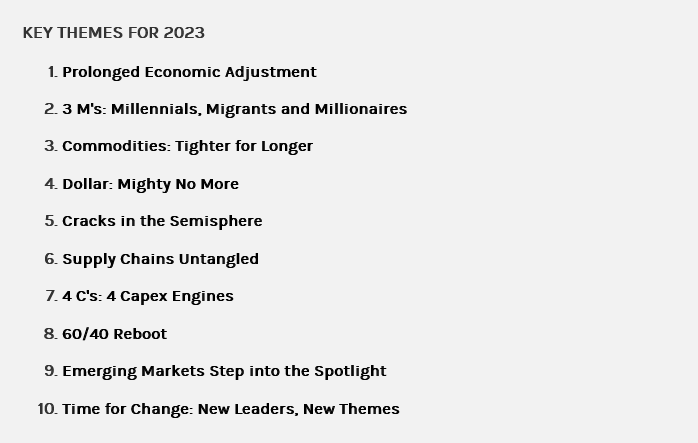
Morgan Stanley IM: Key Themes for 2023

Jitania Kandhari, Deputy CIO, Solutions & Multi Asset Group; Head of Macro & Thematic Research, Emerging Markets; Portfolio Manager, AIA, outlines her Key Themes for 2023.
06.02.2023 | 06:45 Uhr
Here you can find the complete article
The easy money era ended last year as the U.S. Federal Reserve raised rates at the fastest pace since the 1980s to control 40-year high inflation.1 The COVID-19 pandemic has eased, the Russia-Ukraine conflict has reached a stalemate and the global economy is now adjusting to long-lasting impacts that will usher in new investment themes. Most notably among them are migration trends, a declining U.S. dollar, tighter commodity markets, cracks in the semisphere, a revival in Capex, supply chain resiliency and new leadership in economies and markets. In this paper, we roll out our key themes for the year that will likely have major economic, political and market implications.

1. Prolonged Economic Adjustment
The U.S. has experienced its highest inflation in 40 years and the fastest pace
of interest rate hikes since Paul Volcker’s crusade against rising prices in
the 1970s. The percentage of economic forecasters expecting negative growth in
2023 is the highest it has been in the last 50 years at 44%, as the impact of
the lagged monetary tightening is felt across the economy.2 Wall
Street’s view is shared by Main Street as CEO sentiment hovers near historical
lows. The same consensus believes the recession will lead to a fall in
inflation, followed by a Fed pivot and a cut in rates that will propel a growth
pickup and market rally in the second half of the year—the quintessential tale
of two halves of a dip followed by a rip. We believe the economic adjustment
will be more drawn out rather than a V-shaped recovery.
Structural pressures in the labor market, such as a declining workforce, falling immigration and employer incentives to retain workers could limit job market declines. It may take a long time for the unemployment rate to climb from 50-year lows.3 Wage growth at 4-5% suggests no sharp adjustment in consumption and may take sometime to fall to levels consistent with the Fed’s 2% inflation objective.4
The housing sector will also be slow in adjusting given there are few sellers, and the buyers are stepping back. Sixty percent of the housing stock is owned by the 55+ age group that is less likely to relocate or downsize.5 Since many homeowners obtained low interest rate mortgages, there is little incentive for them to sell and buy at a higher mortgage rate. At the same time, higher interest rates have led to a collapse in demand. It will take some time for the housing market price discovery and adjustment to occur.
Although inflation should ease from its recent highs, it could stay higher for longer. The Fed wants to avoid the monetary policy reversals of the 1970s when they tightened on three separate occasions to break the back of inflation, which could be more durable this time given tight labor markets, resource intensive energy decarbonization and less competition due to deglobalization.
1 MSIM, Bloomberg, FactSet, Haver
2 MSIM, Bloomberg, FactSet, Haver.
3 MSIM, Bloomberg, FactSet, Haver.
4 JEF Economics.
5 MSIM, Federal Reserve Board, National Bureau of Economic Research, Empirical Research Partners, Haver.
IMPORTANT INFORMATION
The views and opinions are those of the author as of the date of publication and are subject to change at any time due to market or economic conditions and may not necessarily come to pass. The views expressed do not reflect the opinions of all investment personnel at Morgan Stanley Investment Management (MSIM) and its subsidiaries and affiliates (collectively the Firm”), and may not be reflected in all the strategies and products that the Firm offers.
This material is for the benefit of persons whom the Firm reasonably believes it is permitted to communicate to and should not be forwarded to any other person without the consent of the Firm. It is not addressed to any other person and may not be used by them for any purpose whatsoever. It expresses no views as to the suitability of the investments described herein to the individual circumstances of any recipient or otherwise. It is the responsibility of every person reading this material to fully observe the laws of any relevant country, including obtaining any governmental or other consent which may be required or observing any other formality which needs to be observed in that country.
This material is a general communication, which is not impartial, is for informational and educational purposes only, not a recommendation to purchase or sell specific securities, or to adopt any particular investment strategy. Information does not address financial objectives, situation or specific needs of individual investors.
Any charts and graphs provided are for illustrative purposes only. Any performance quoted represents past performance. Past performance does not guarantee future results. All investments involve risks, including the possible loss of principal.
Prior to making any investment decision, investors should carefully review the strategy’s / product’s relevant offering document. For the complete content and important disclosures, refer to the link above.
© 2023 Morgan Stanley. All rights reserved.



Diesen Beitrag teilen: